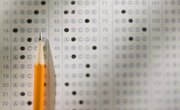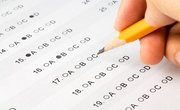High stakes testing has become common in elementary schools across the United States, as governments and schools try to work together to improve standards, teaching quality and learning. In elementary schools, there are serious consequences for students and schools who perform poorly on tests. Disadvantages to high-stakes testing are easily identified, yet teachers and schools are held responsible if scores are not acceptable.
High Pressure on Elementary Students

Pressure to succeed on high stakes tests is felt by students, resulting in anxiety for young children. Major decisions are often made based solely on the results of high stakes testing. Elementary students suffer as the pressure to succeed weighs heavily on them. Children who do not perform well on tests may suffer from lack of self-esteem and reduced self-worth. According to Sociology of Education, self-concept is strongly related to perceived intellectual abilities.
Low Morale

Elementary students, teachers and parents all experience stress and anxiety over standardized testing. If scores are low, teachers may begin to lose motivation to try to help students succeed. Students often feel frustrated by high stakes testing. Parents become frustrated as they are unable to help or remedy the situation.
Consequences for Low Scores

Elementary schools with poor test scores are at risk of losing federal and state funding. If scores do not improve within a set amount of time, the school may be forced to submit to government takeover or major restructuring, according to a report from the Center for Comprehensive School Reform and Improvement. Teachers often fear repercussions if students do not pass high stakes testing, leaving educators tempted to succumb to corruption or to cheat, according to The National Association of School Psychologists.
Teaching to the Test

To help students pass high stakes standardized testing, schools are forced to eliminate subjects that will not be tested. Music and art are often reduced or eliminated, in favor of increasing instructional time in reading or math. Elementary schools are already pressed for time to accommodate all of the daily requirements and responsibilities. To cover material needed to pass a high stakes standardized test, teachers are forced to wait to teach other topics until the testing is complete. Others remove additional topics from the curriculum completely.
Poor Design

High stakes tests generally do not assess higher order thinking or reasoning. Computerized grading is often used to score the exams. Children with special needs or children with different styles of learning are not adequately assessed using these styles of tests, or simply not tested at all. The National Center for Learning Disabilities states that standardized tests are some of the worst ways to assess children with learning disabilities. Accommodations can be made to assist special needs children, but all children suffer from the generalized nature of the tests.
Related Articles
References
- National Association of School Psychologists: High-Stakes Testing and No Child Left Behind: Information and Strategies for Educators
- ASCD: Research Says… / High-Stakes Testing Narrows the Curriculum
- National Center for Learning Disabilities: The Trouble with High Stakes Testing
- West Ed: High-Stakes Testing
- Sociology of Education: The Social Effects of Standardized Testing on American Elementary and Secondary Schools
Writer Bio
Amy Pearson earned dual bachelor's degrees in management and horticulture. She is a licensed elementary teacher for kindergarten through sixth grades. Pearson specializes in flower and vegetable gardening, landscape design, education, early childhood and child development.











